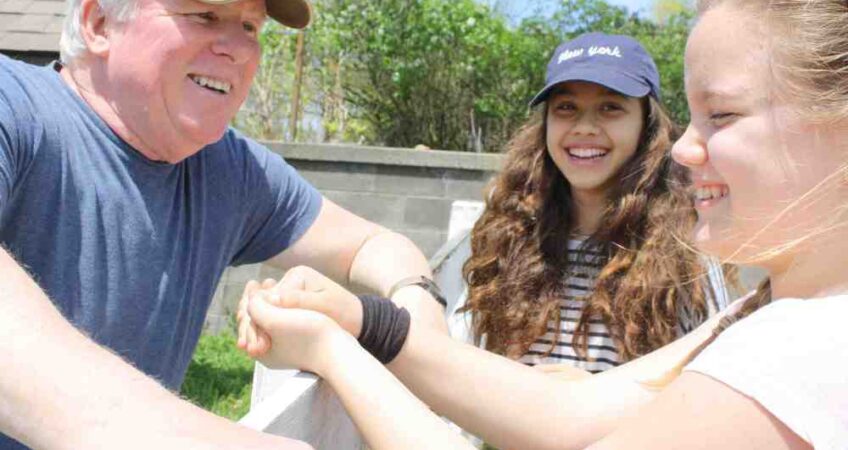
The Unwritten Curriculum

“It is said that the teacher’s presence in the classroom is the unwritten curriculum.”
-Adele Caemmerer, from “Planting Seeds; Practicing Mindfulness with Children” by Thich Nhat Hanh
At this time of year, I can always feel the dread of “back-to- school” that used to haunt me as a child. I would get it in the pit of my stomach, the feeling of anxiety over the “first day of school.” Would I make friends? Would my teachers like me? Would I like them? Even though I don’t go back to school in the fall, and my weekly students are all homeschoolers who don’t go back to school, and the refugee and shelter teens I work with are also not going back to school, I still feel the frequency everywhere. It’s in the long lines at Staples and CVS for school supplies. It’s on the sidewalks, as children return from summer camps and vacations abroad. It’s in the shopping malls and catalogs, advertising fall clothing and back-to-school fashions.
Why is it “back” anyway? We aren’t back, we have moved on. Children grow up so much in the summer time, they aren’t the same as they were. So why isn’t it “forward?”

I love to say to young children on the first day I see them in the fall, “Welcome forward!” It makes them smile, because it’s different and it makes sense.
On the first day, we always talk about the quality of “respect,” how the word could mean: “to look again” (re-spect). Because we are different, we greet each other on the first day as if we don’t know each other, and so we introduce ourselves to one another as if we were just meeting. It’s a ceremony that makes everyone giggle, and yet they feel really settled afterwards, knowing they have been recognized as different, not the same as they were in the spring, and it makes them stand just a little bit taller.
I’m interested in how some public school teachers manage their classrooms, unlike the nature-based settings that I lead educational programs in. The classroom becomes like a domain, and depending on the teacher, there can be an atmosphere in the room itself that children walk into and it conditions their behavior, by how comfortable (or uncomfortable) they feel there. One teacher that I know well, keeps the fluorescent lights off in her classroom all the time, and only uses a few lamps. It makes the light so much softer, and immediately, the students register a feeling of calm in her room, and so they are calmer.
But I also notice sometimes that teachers in some situations seem to have lost their joy of teaching, their love of children, and have become managers of behavior. They seem almost afraid to allow children to be themselves, for fear of what might happen if they get too loud or too excited. In Middle School especially, I hear teachers clapping their hands repeatedly to get their students’ attention. Or worse, one 8th grade teacher in a parochial school classroom, used to bang on one of those bells on the table until the students stopped talking. She did it incessantly: bangbangbangbangbangbangbang. It didn’t really endear them to her, and it didn’t really get their attention either.
I have heard a teacher enter the classroom and say, “Good morning everyone!” in a threatening voice and when the students repeated in a feeble monotone, “Good morning Mrs. So-and- so,” she raised her voice to a more strident pitch and repeated, “GOOD MORNING EVERYONE!” They then realized what was required and said a little more loudly in unison, “Good morning Mrs. So-and- so!” I got that feeling in the pit of my stomach, that one that came with the first day of school. It is a feeling that smells of lunchboxes and milk, cafeteria tables and garbage cans overflowing with unwanted food, and the sound of shoes squeaking on linoleum floors. It goes with wet toilet paper wads stuck on the ceiling of the bathroom that might fall on you unexpectedly, and teasing messages scratched onto the back of the door of the toilet.
It’s the feeling of being caught not knowing the answer, or not paying attention. It’s the sound of the second hand ticking on the clock on the wall, or seeing it spinning silently as you wait for the bell that releases you to the next class. It’s the banging of lockers, the smell of school bus exhaust, the voices yelling in the playground.

Last spring, when I was leading “Think out of Bounds” workshops twice a week in a public school classroom, it hit me that the children were so nervous about making a mistake because their training was to only get the answer right. So that prevented them from trying new things, experimenting with ideas, and thinking in new ways.
They were inhibited because if they looked silly or stupid in some one else’s eyes, they would be laughed at. And here I was, asking them to “think outside the box,” and all they’d been taught was to stay very firmly inside that box, and I was expecting them to freely express themselves in 40 minutes, between bells.
One day after class, I saw a teenage girl shaking in the hallway, almost whispering to the teacher in the classroom, “I think I forgot my homework folder inside the room,” she was stammering. I thought to myself, why doesn’t she just say, “I left my homework folder in the room, can I please go get it?” But she was, I realized, so frightened of having lost it, of having made a mistake, of leaving it behind, and what would the teacher say, and how would she say it?
It caused me to realize that whatever I taught the children from then on, what they really needed was my genuine love and support. They needed to feel that I was inspired by them (which I was) and that I thought they were fantastic, creative people (which they were), and the more I encouraged them and expressed my real awe at what they were capable of, the more they were actually able to think outside the box. They started to astound me with their ideas, and the more I put a warm hand on their shoulders, laughed at their jokes, smiled at their attempts, the happier they got. And they became more respectful, better listeners, quicker at our games and exercises, and better team players. It was so clear to me by the end of the year, that all they really needed was the presence of a teacher who believed in them.
“The transformation of our schools and our society begins with the transformation of ourselves through the practice of cultivating mindful awareness.”
-Adele Caemmerer
